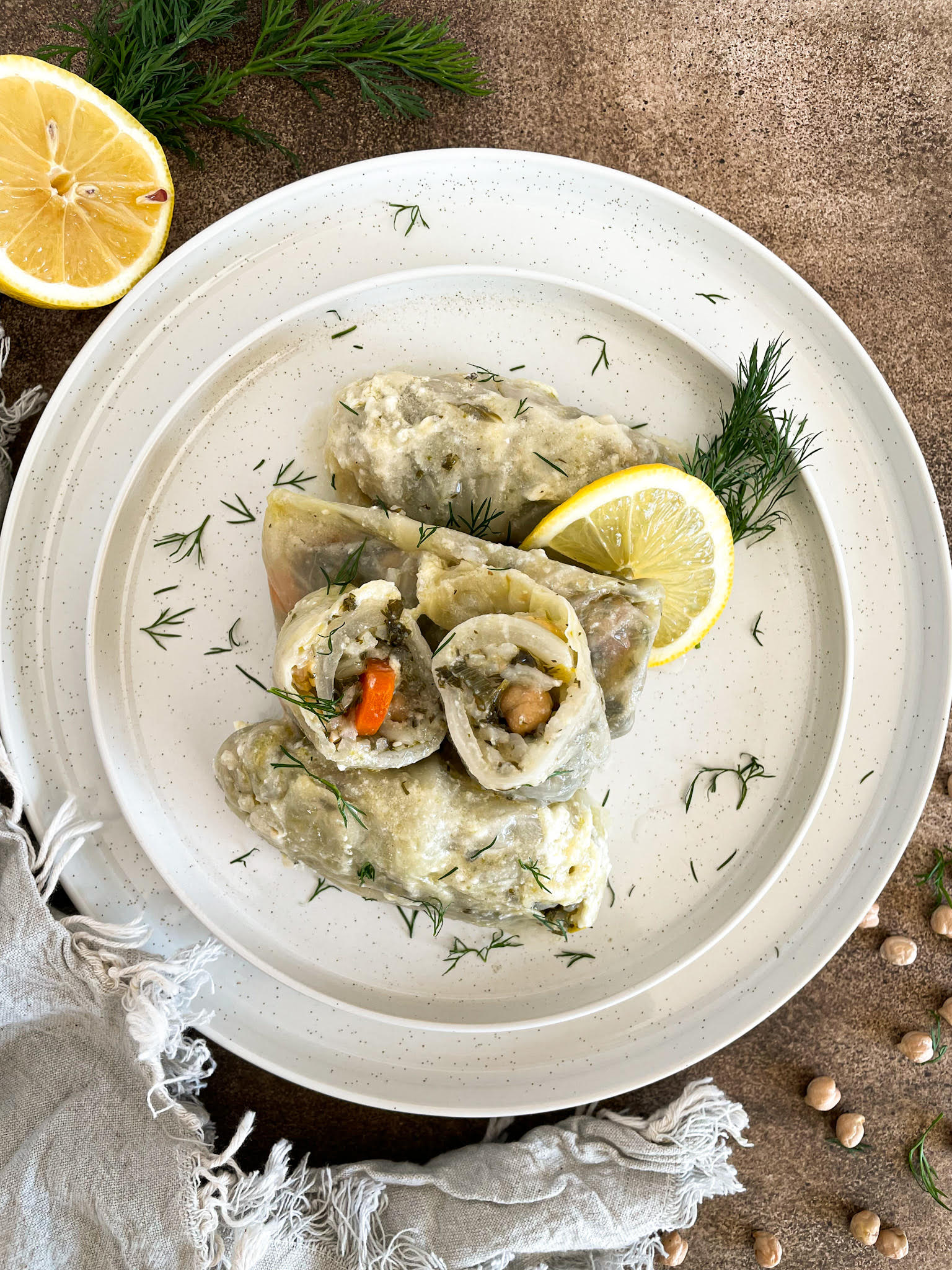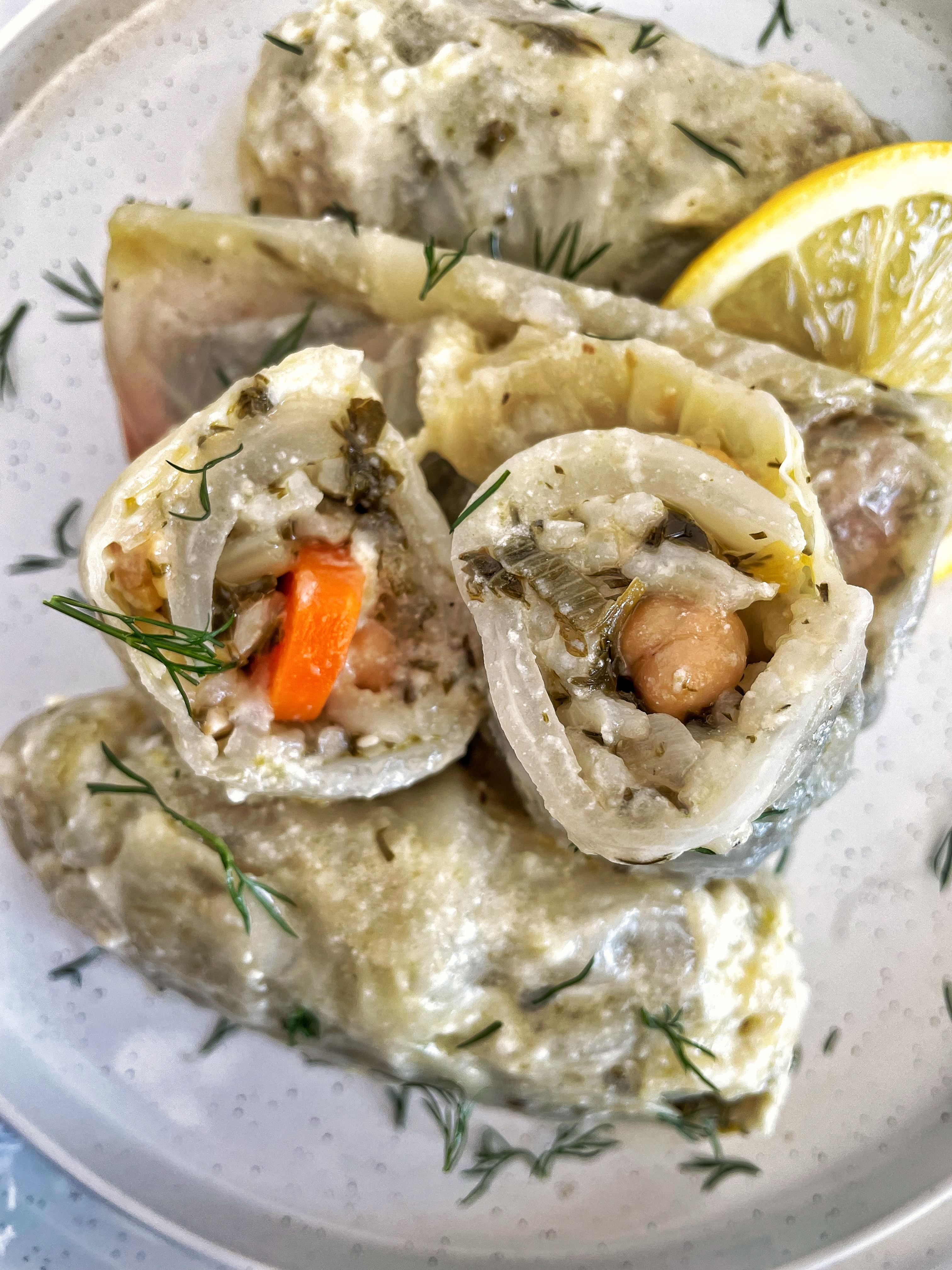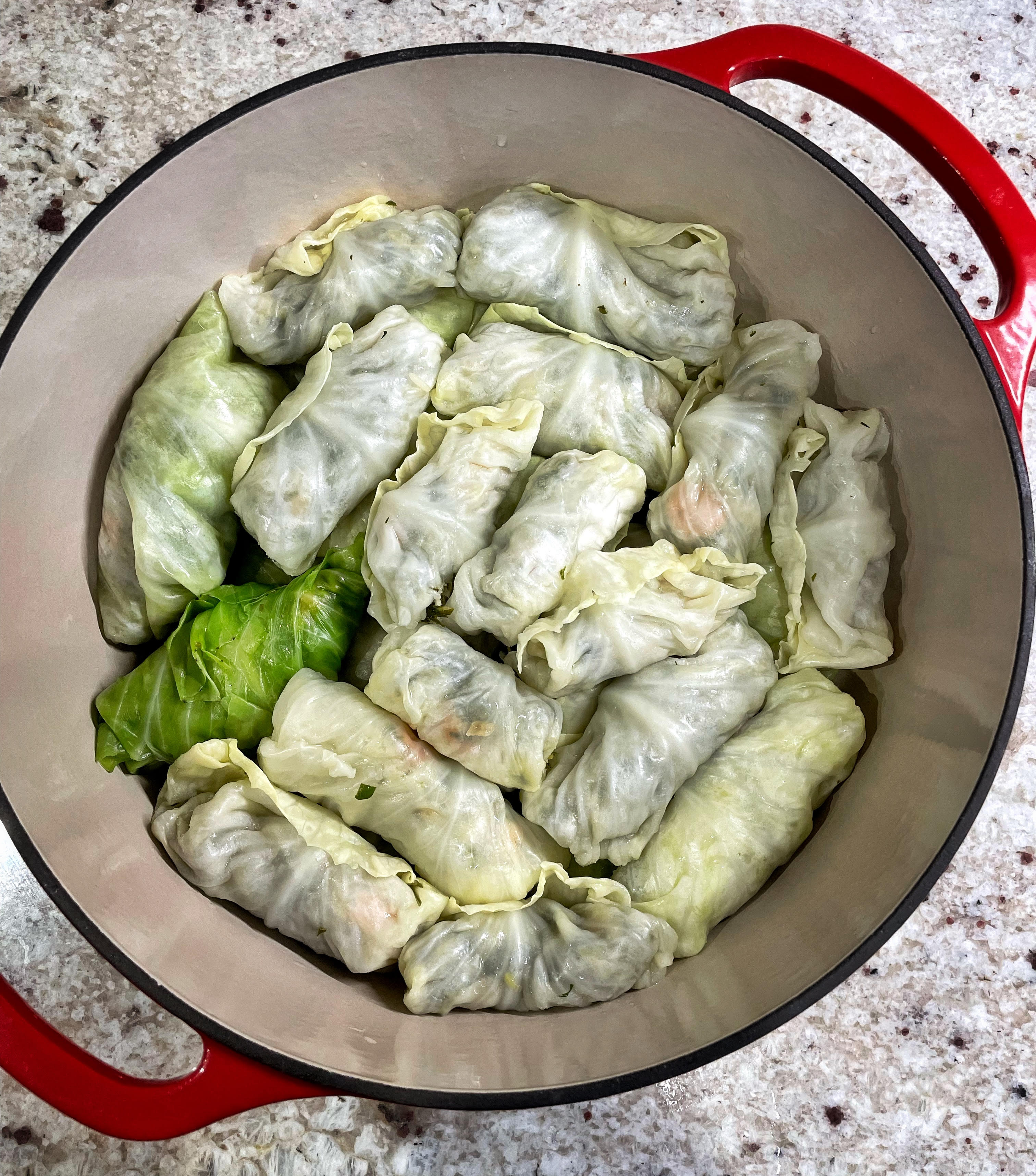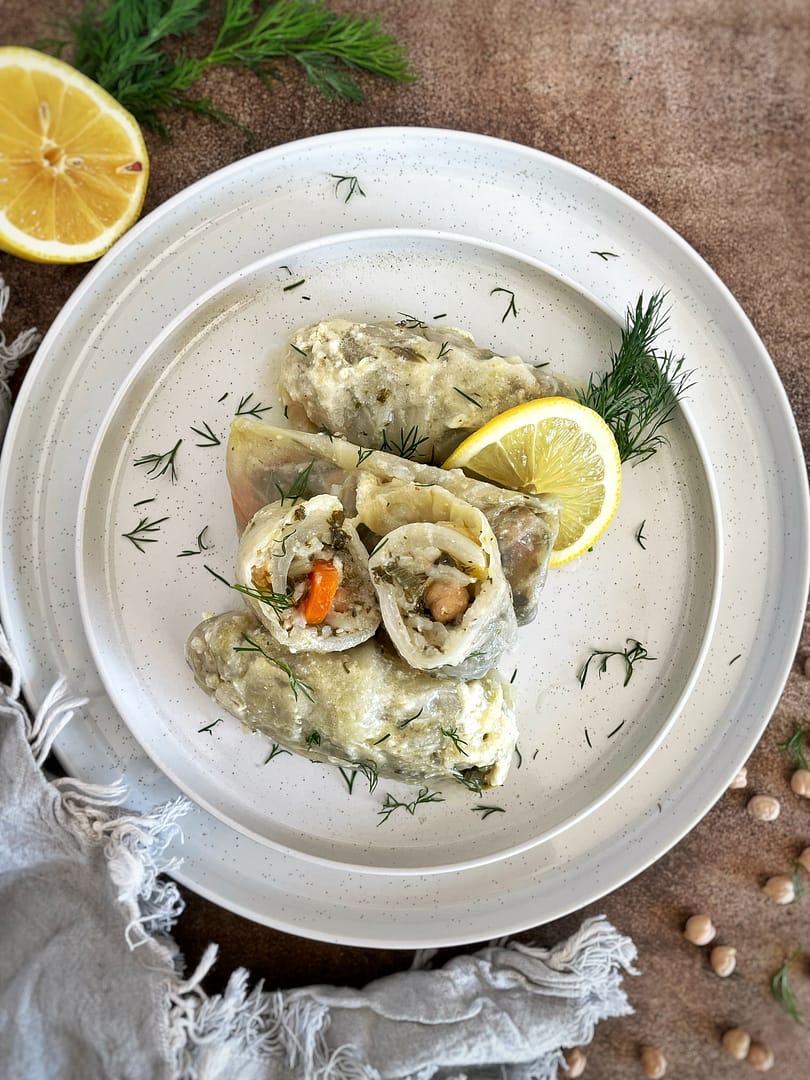These chickpea and rice stuffed cabbage rolls are complete with carrots, celery and an abundance of fresh herbs to create a well-balanced dish with flavor that will knock your socks off!

Growing up as a Greek child, laxano dolmades, or stuffed cabbage rolls, were one of my favorite dishes. I would beg my aunt to make them for me! The original recipe is made with ground beef and rice. Today, I’m coming to you with a glow up of this dish, the traditional transformed into Chickpea and Rice Stuffed Cabbage Rolls. I’m totally not mad about it. In fact, I am over-the-moon ecstatic because this glow up creates a more balanced dish that doesn’t sit in your belly like a slab of concrete but is still packed with flavor and nutrition. Let’s get rollin’!
The Traditional vs The Glow Up
As I mentioned above, the traditional recipe is made with ground beef, rice and herbs. I have made a plant-based version of the traditional here using a vegan meat alternative, like Beyond Meat. In our glow up version, we’re going straight whole foods! We’re swapping out the vegan ground beef with chickpeas! Chickpeas are amazing little beans that are affordable, highly nutritious, and can be transformed into an array of delicious dishes: hummus, falafel, tossed into salads, smashed into chickpea “tuna” salad wraps, bean and veggie burgers, and more.
Chickpeas are packed with nutrients! Check this out: one cup of cooked chickpeas has 14.5 grams of protein, 12.5 grams of fiber, and a whole host of vitamins and minerals like folate and iron. Regularly consuming fiber can help keep your bowels stay regular, help feed the good bacteria in your gut microbiome, help regulate blood sugar and help you stay full. Chickpeas for the win!
In addition to chickpeas, we’re also adding carrots and celery. These two veggies are just another way to enhance flavor and add more body and volume to these Chickpea and Rice Stuffed Cabbage Rolls. I love rice as much as anyone but it does need some help flavor-wise. Speaking of flavor, do not forget to use fresh herbs for this! Fresh parsley, mint and dill add such a pungent smell and a mouthful of sweet zippiness that amps up the rice.

The Sauce
Let’s get down to the sauce. Traditionally, this dish is made with an egg lemon sauce. If you aren’t fully plant-based and eggs are an option for you, then the traditional sauce may work for you. If you are plant-based, allergic to eggs or fasting for lent and cannot use eggs, then I have 2 other solutions for you.
The first solution is to replicate the sauce using aquafaba instead. Aquafaba is the starchy viscous water that legumes have been cooked in. In canned chickpeas (which is what I used), it’s simply the liquid in the can. Therefore, do not throw away the liquid when you drain your chickpeas. Save it for the sauce! Or you can use it for vegan buttercream frosting, vegan macarons, mousse, and more. You simply whip up the aquafaba with some cornstarch and lemon juice in a very precise process, combine it with the broth and then pour over the cabbage rolls.
The second solution is to opt for a tomato-based sauce. Pour the broth from your pot of cabbage rolls into a bowl and then whisk in 1-2 tbsp of tomato paste. Then pour the broth back over the rolls. The tomato paste will be seasoned by the broth that has been cooking and simmering for 45 minutes.

The Process
Let’s discuss the process. This is a lengthier recipe so you will need to carve out adequate time for preparation and cooking. First, setting out all of your ingredients and tools is going to be a huge timesaver. You’ll need a big pot for boiling and cooking the cabbage, a sheet pan or tray to hold the leaves, a mixing bowl, a skillet for sauteing the filling, a ladle, tongs and a whisk. If you need an amazing cast iron Dutch oven pot (the red one in the image above that I used), you can find that link here!
The Cabbage – Coring
Second, we’ll need to boil the cabbage. Start out by filling up a big pot three quarters of the way with water and set it to boil. While the water is heating up, you’ll need to core the cabbage. With a small sharp paring knife, carve out about 2 – 2.5 inches deep. I like to start by slicing a diamond or square around the core and then slowly carve out the core of the filling with the knife. We need to core the cabbage so that when it boils, the leaves will gently come off the head of cabbage without tearing.
The Cabbage – Boiling
When the water is boiling and you have cored the cabbage, put the head of cabbage in the water. It takes about 10 minutes initially for the cabbage to even get soft enough for the leaves to start coming off. You will notice that the color of the cabbage will change from a bright green to a darker, more muted green color as it boils.
With the tongs and the paring knife, or even a large pot fork, gently peel off the leaves and set them aside in a tray to cool. If you have to pull too hard, the cabbage hasn’t boiled enough. It should require the smallest of tugs to help the leaf come off. Sometimes, it can require a little slice of the paring knife to separate the leaf from the core. The initial larger leaves on the outer part of the cabbage are much easier and usually come right off.
As you remove leaves and the cabbage becomes smaller, it will require a little more finesse to release the leaves from each other. Try to separate as many leaves as you can and once you’ve gotten to the end, you can even pull the cabbage head out and rest it on a cutting board. It will be easier to get to those smaller leaves. You may not be able to stuff some of those smaller leaves but don’t throw them away! We’ll add them to the bottom of the pot and they’ll cook along with the rolls.
Don’t throw away the water in the pot. We’ll use that to boil these Chickpea and Rice stuffed cabbage rolls since the water will already be hot.
Filling and Rolling
As the cabbage leaves are cooling, we’ll make the filling. Then we’ll take the filling and stuff the cabbage rolls. Some people like to go one by one. However, if you have a large enough workspace, you can lay out all the leaves and add the filling to them prior to rolling so you can see if you have just enough of the ingredients or will require more.
The larger leaves will require about 1 – 1.5 tablespoons of filling. The smaller leaves will take 1 – 1.5 tsp. Rice expands when it cooks so if these cabbage rolls are overfilled, they will likely unravel or burst during cooking. Thus, less can be way more! You don’t want that yummy filling just floating around the pot!
Place the filling towards the bottom of the leaf. Roll over once from the bottom. Tuck the sides over and then continue to roll tightly. Rolling cabbage leaves is the same as rolling grape leaves, burritos, wraps, etc. If you need a visual, check out this video I made on rolling grape leaves. It’s the same technique! The video is towards the bottom of the post.
Extra Filling or Leaves
In some instances, we have extra cabbage leaves. If that’s the case, you’ll just line the bottom of the pot with the extra leaves before adding your cabbage rolls in.
In other instances, we have extra filling. There are four options to this scenario.
1. Go buy another cabbage and use up the filling.
2. Freeze the filling in an air tight container and use it for next time (my least favorite option).
3. Add the filling to a small pot with some water or broth and simmer covered, as you would rice, until fully cooked through. That gives you a side of rice!
4. Go through your fridge and see what other leafy greens you may have laying around. Collard greens work great, also! I recommend parboiling them before rolling.

Cooking the Cabbage Rolls
Add the cabbage rolls to a pot. If you’re using the same pot where you boiled the cabbage, just pour the water into a bowl to save it. Tuck the rolls in tightly against each other and then on top of each other as you fill the pot. Any extra leaves can line the bottom of the pot or be tucked in snugly between the rolls.
Then, and this is important, place a dinner plate on top of the cabbage rolls. If you don’t have a small enough plate, use a heavy heat-safe bowl. The dinner plate will hold the grape leaves down as they are boiling, preventing them rising and unfolding. A lid for your pot will not work as it only covers the pot, it does not hold down the cabbage rolls. Once the water is boiling, reduce the heat to medium-low and simmer for forty five minutes.
Preparing the Sauce
When there is ten minutes left of cooking, it’s time to prepare the sauce. As I mentioned before, the traditional sauce is an egg lemon sauce. In this case, we’re swapping the egg whites with aquafaba and we’re using a stabilizer and thickener to help with the texture of the sauce.
Aquafaba is the liquid from a can of chickpeas. The stabilizer (to help keep the aquafaba keep it’s shape) is cream of tartar. This is optional but recommended. The thickener is a wee bit of corn or arrowroot starch. We require the starch to help provide a bit of a fuller body that the eggs normally have.
First, you’ll start by lightly beating the aquafaba in a big bowl with a hand mixer. Next, when it starts to foam, you’ll add the cream of tartar and beat at high speed for about 5-6 minutes. The aquafaba will whip and become puffy like egg whites.
Once the aquafaba is whipped, set that aside and prepare the last portion of this sauce. You’ll squeeze the lemons and then whisk one tablespoon of starch into the lemon juice. Once it’s fully combined, pour that into the bowl of whipped aquafaba.
The Last Step!
Lastly, once the cabbage rolls are done cooking (and you’ve tried the inside of one of the rolls to make sure the rice is done), we combine everything together.
Turn off the heat, keep the dinner plate in place and carefully drain the broth from a pot into a measuring cup. Once most of the broth has been poured out, you can set the pot aside and remove the dinner plate. Next, grab a whisk in your dominant hand. With your other hand, slowly start pouring the broth into the bowl of aquafaba while continuously whisking with the dominant hand. Do this until all the broth is whisked in and combined. Then, pour the bowl of aquafaba and broth back into the pot over the cabbage rolls. Then you’re ready to serve! Pair with some fresh, warm bread, a little feta, and some kalamata olives for the ultimate Greek experience!
I know this Chickpea and Rice stuffed cabbage rolls dish is a little lengthy and requires some serious commitment but DO IT! You won’t regret it once that forkful hits your mouth!

Chickpea and Rice Stuffed Cabbage Rolls
Equipment
- Hand Mixer
- Skillet
- Big Pot
- Ladle
- Whisk
- Tongs
- Pot Fork
Ingredients
- 1 large green cabbage
- 1/2 cup jasmine or basmati rice
- 1 large onion
- 3-5 cloves of garlic
- 1/4 cup olive oil
- 1 cup diced carrots
- 1 cup diced celery
- 3 scallions/green onions
- 1 15oz can of chickpeas drained and rinsed
- 2 cups fresh parsley leaves chop after measuring
- 1/4 cup fresh chopped dill
- 1/4 cup fresh chopped mint
- 1.5 tsp salt
- 1/2 tsp pepper
- 1 tbsp dried oregano
- 1 cup water
Lemon Sauce
- 1/3 cup aquafaba
- 2 lemons, juiced
- 2 tbsp corn starch
- 1/4 tsp cream of tartar optional
Instructions
- Set a large pot of water to boil.
- While the water is heating, core the cabbage. Cut out the core of the cabbage with a sharp knife, about an inch wide and about 2 inches deep, angling towards the center of the cabbage. Don't go too wide or too deep – we want to keep the cabbage leaves in tact.
- Boil the cabbage, core side up. As the cabbage boils, the outer leaves will soften so that you can easily peel them off and set them aside. If you have to pull, the leaves are not soft enough and require additional boiling. Boil and peel the leaves off the whole cabbage. Set the leaves aside to cool. Save the water and set aside.
- Dice the onion, garlic and scallions and add to a skillet with olive oil. Saute over medium heat until softened and translucent.
- Add the carrots, celery, spices and herbs and sauté until well incorporated and softened, about 5 minutes.
- Then add the rice, chickpeas, and water. Saute for just a minute or two or until the water has been absorbed. Turn off the heat and set the filling aside.
- Next, fill and roll the cabbage leaves. Add a tablespoon of filling towards the bottom of the leaf. Roll once from the bottom up. Then fold over the sides. Then continue rolling up tightly like a burrito.
- Line a big pot with unused cabbage leaves. Then layer the cabbage rolls tightly against and on top of one another. Add a small drizzle of olive oil and salt and pepper to season the actually cabbage itself. Then add the hot water from before until the cabbage rolls are just covered. Finally, place a dinner plate on top of the cabbage rolls.
- Bring the cabbage rolls to a boil. Then reduce the heat to medium-low and simmer for 45 minutes with the dinner plate on top of the leaves.
Making the Sauce
- When there's ten minutes left of cooking time, prepare the sauce. Begin by adding the aquafaba to a big bowl and beat with a hand mixer. Once the aquafaba starts to get foamy, add the cream of tartar and then beat on high until fluffy, about 5-6 minutes.
- Juice the lemon and whisk the cornstarch into the lemon juice. Then add that to the bowl of aquafaba.
- Once the cabbage leaves have finished cooking, drain the broth from the pot into a measuring cup. Set the pot aside and remove the dinner plate.
- With one hand, pour the broth slowly into the bowl of aquafaba and with the other hand, whisk at the same time. Whisk until the broth has been fully emptied into the aquafaba.
- Pour the aquafaba sauce over the cabbage rolls and then drizzle the cabbage rolls with olive oil, salt and pepper.
- Gently scoop out the rolls and some broth onto a plate and serve. Top with fresh dill if desired.
Notes
Did you make this? Leave a comment below and share a picture on Instagram with the hashtag #thewholescoopblog





